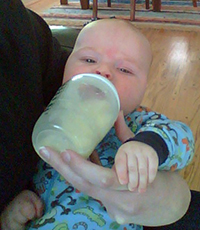Getting Support for Bottle Feeding

Many parents use a bottle to feed their baby. Feeding is an important topic for PEPS Groups that is relevant again and again at all stages of a child’s growth and development. There are many resources that PEPS Parents share about the challenges and successes they have with bottle feeding. Here are some resources to help support you as you learn about feeding your baby.
Making feeding a great time with your baby
No matter who is feeding the baby, this is a good way to be close and spend important time together.
- Get comfortable with a favorite chair or sofa with support for your back, feet and arms
- Consider skin to skin when a parent is feeding baby
- Gaze at baby – this is a great time for quiet conversation with your baby and to look at each other
- Learning time can happen too. Sometimes your baby can be eating and want to interact with you. You can touch and name the parts of the body, say rhymes with animal sounds or other activities
- If baby likes to close their eyes, it can be a good time to sing a soft song or read quietly aloud
- Bottle feeding can be on the go, so not every time is perfect for being cozy and close
Techniques for Using a Bottle
Because a bottle may flow more quickly, these ideas can help the baby can have more control over how fast they eat:
- Hold the baby in a more upright position, not laying flat
- Hold the bottle in a more horizontal position, not vertical
- Slow down the feeding, re-adjust to the baby’s pace, take a break or call it done by reading the baby’s cues
- External resources
- Best for Babes article with photos and information
- Nurtured Child article Baby-led Bottle Feeding
What’s in the Bottle? Nutrition and Safety
Preparing bottles and formula can be tricky, and information about food safety has changed over the years.
- The World Health Organization has a guide on How to Prepare Formula for Bottle-Feeding at Home with info on sterilizing, storing and preparing formula safely; also a guide for Cup-Feeding
- Choosing a Formula from Healthy Children.org (American Academy of Pediatrics) with descriptions of cow’s milk, hydrolyzed/predigested/hypoallergenic, soy, and specialty formulas
- Powder, liquid concentrate or ready-to-feed describes preparations of formula from Healthy Children.org (American Academy of Pediatrics)
- Kids with Food Allergies describes What to Feed Your Allergic Infant if allergy is a concern
Donor milk
You may want to check with your doctor, midwife or hospital for resources and referrals for safely using donor milk.
- Donate Breast Milk at Swedish
- The Breast Milk Depot at Providence makes milk available to sick and fragile infants
- Nonprofit milk banks: Northwest Mothers Milk Bank
- Other Mothers' Milk: Is Mom-to-Mom Sharing Safe? article from ParentMap
Breast milk
- Resources for using your own breast milk
- PEPS Resource on Breastfeeding
- Breast Milk Storage from the Mayo Clinic
- Storage Duration and Temperature chart at the CDC
- Storage Guidelines from La Leche League
- Storage info and chart from Dr. Sears
Amount of feeding questions
Babies can take in a lot when feeding from a bottle and may overfeed, which can be one of the many reasons they spit up often or have increased gas.
- Knowing that baby is getting enough is based on wet diapers and weight gain. You can chart the ounces the baby eats, the number of wet diapers and check with your pediatrician to be sure that your baby is eating enough
- How Often and How Much Should Your Baby Eat from Healthy Children.org (American Academy of Pediatrics)
Bottle Gear
PEPS Parents share ideas on new baby gear with their groups, and it’s a great way to hear about new products that you might want to try.
- Ask Dr. Sears article on Alternatives to Bottles, including cup, dropper, spoon, and finger
- Many PEPS Groups choose a weekly meeting to bring bottles, nipples, formula or other gear that has worked or not worked for them to share or swap with others
There is so much information available on bottle feeding that you may find conflicting information about formulas and allergy, formula helping or hurting breast milk supply, issues around nipple confusion, ways to encourage taking the bottle and more. This quote from the Australian Breastfeeding Association captures a positive point of view:
Regardless of whether a mother exclusively breastfeeds, exclusively uses formula or does a combination (mixed feeding), she has done her very best and has made decisions that were right at the time, based on the support and information she had available to her. ABA
This statement of support goes for all parents who are feeding their babies and helping them grow!
External Resources
General resources on all topics related to bottle feeding:
- American Academy of Pediatrics on bottle feeding, formula and nutrition
- Fearless Formula Feeder is a well-maintained bottle-feeding blog with lots of tips and helpful support. Their tagline is Standing Up for Formula Feeders Without Being a Boob About It
- Tips for how partners, friends, and family can support breastfeeding, pumping, and formula-feeding parents.
- Infant Nutrition flyer from H.E.R.E. at the Washington Department of Health
- WIC Works resources
Document Actions